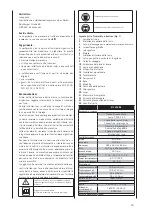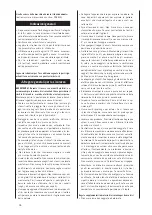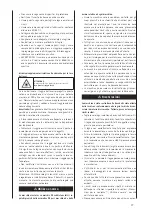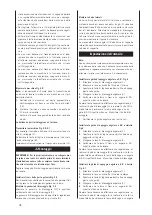
13
Additional safety instructions for laser light
Achtung! - Laserstrahlung
Nicht in den Strahl blicken!
Laser Klasse 2
Laserspezifikation nach EN 60825-1:2007
λ= 650 nm P ≤ 1 m
W
0
ATTENTION: -
Faisceau laser
ne pas regarder dans le faisceau laser!
Longueur d’onde = 650 nm
Puissance max. restituée : ≤ 1m
W
Laser de classe 2
EN 60825-1:2007
Attention! - laser radiation
Do not stare into beam!
laser class 2 product
laser specification according to
EN 60825-1:2007
λ= 650 nm P ≤ 1 m
W
0
AttENtiON
This unit is a class 2 laser product.
Do not stare into beam!
The laser light and laser radiation used in this system
comply with class 2 and a maximum performance of 390
µW and 650 nm wave length. Normally laser does not
represent an optical danger, although staring into the
beam can cause flash blinding.
Warning:
Do not look directly into the laser beam, since
this could represent a risk. Please observe the following
safety instructions:
• The laser may only be used and maintained in accord-
ance with the instructions of the manufacturer.
• Only point the beam onto the work piece, and never at
a person or another object.
• The laser beam must not deliberately be pointed at
persons. It must not be pointed into the eyes of a
person for more than 0.25 seconds.
• Always make sure that the laser beam is directed onto
a robust work piece without a reflecting surface. That
means that timber and materials with a rough surface
are acceptable. Shiny, reflecting plates or similar ma-
terials are not suitable for laser, since the reflecting
surface could return the beam to the operator.
• Do not exchange the laser light unit for another type.
Repairs have to be conducted by the manufacturer or
an authorised specialised company.
Caution: You must only apply the regulation and adjust-
ment tools and methods described in this manual. Non-
observance can lead to dangerous radiation.
m
Proper use
CE tested machines meet all valid EC machine guidelines as
well as all relevent guidelines for each machine.
• The machine must only be used in technically perfect
con dition in accordance with its designated use and
the in structions set out in the operating manual, and
only by safety-conscious persons who are fully aware of
the risks involved in oerating the machine. Any func-
tional dis orders, especially those affecting the safety of
the machine, sholud terefore be rectified immediately.
• Any other use exceeds authorization. The manufacturer
is not responsible for any damages resulting from un-
authorized use; risk is the sole responsibility of the
operator.
• The safety, work and maintenance instructions of the
manufacturer as well as the technical data given in
the calibrations and dimensions must be adhered to.
• Relevant accident prevention regulations and other,
gene rally recognized safety-technical rules must also
be adhered to.
• The machine may only be used, maintained, and op-
erated by persons familiar with it and instructed in its
operation and procedures. Arbitrary alterations to the
machine release the manufacturer from all responsi-
bility for any resulting damages.
• The machine may only be used with original accesso-
ries and tools made by the manufacturer.
m
Remaining hazards
the machine has been built using modern technology in
accor dance with recognized safety rules. Some remaining
hazards, how ever, may still exist.
• Only process selected woods without defects such as:
Branch knots, edge cracks, surface cracks. Wood with
such defects is prone to splintering and can be haz-
ardous.
• Wood which is not correctly glued can explode when
being processed due to centrifugal force.
• Trim work piece to a rectangular shape, center and
cor rectly secure before processing. Unbalanced work
pieces can be hazardous.
• Long hair and loose clothing can be hazardous when
the work piece is rotating. Wear personal protective
gear such as a hair net and tight fitting work clothes.
• Saw dust and wood chips can be hazardous. Wear per-
so nal protective gear such as safety goggles and a dust
mask.
• The use of incorrect or damaged mains cables can lead
to injuries caused by electricity.
• Even when all safety measures are taken, some re-
maining hazards which are not yet evident may still
be present.
• Remaining hazards can be minimized by following the
instructions in „Safety Precautions“, „Proper Use“ and
in the entire operating manual.
• Do not force the machine unnecessarily: excessive
cutt ing pressure may lead to rapid deterioration of the
blade and a decrease in performance in terms of finish
and cutting precision.
• When cutting aluminium and plastics always use the
app ro priate clamps: all workpieces must be clamped
down firmly.
• Avoid accidental starts: do not press the start button
while inserting the plug into the socket.
• Always use the tools recommended in this manual to
obtain the best results from your cutting-off machine.
• Always keep hands away from the work area when the
ma chine is running; before performing tasks of any
kind release the main switch button located on the
handgrip, thus disconnecting the machine.
• Always keep hands away from the work area when the
machine is running; before performing tasks of any
kind release the main switch button located on the
handgrip, thus disconnecting the machine.
Fixing the Machine Fig.2.0
Note:
we strongly recommend that you fix the mitre saw
safely on a workbench so that your machine is as stable
as possible.
1
Place the machine at the appropriate place and mark
the four bolt holes (15) on the workbench.
2
Drill the holes using a 10 mm drill.
3
Fix the saw on the workbench using bolts, washers
and nuts.
Mounting material is not included.














































